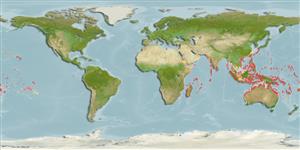>
Gobiiformes (Gobies) >
Gobiidae (Gobies) > Gobiinae
Etymology: Valenciennea: From Achille Valenciennes 1794-1865; he worked with Duméril, Cuvier and Lacepède since 1815; malacologist, author of a "Histoire naturelle des poissons" (Ref. 45335).
Environment: milieu / climate zone / depth range / distribution range
นิเวศวิทยา
เกี่ยวกับทะเล,น้ำเค็ม เกี่ยวกับหินโสโครก; ระดับความลึก 1 - 25 m (Ref. 48637), usually 1 - 6 m (Ref. 8527). Tropical; 22°C - 28°C (Ref. 27115); 31°N - 35°S, 24°E - 132°W
Indo-Pacific: East Africa to Tuamoto Islands, north to the Ryukyu Islands, south to Sydney, Australia, including Lord Howe Island.
ขนาด / น้ำหนัก / Age
Maturity: Lm ? range ? - ? cm
Max length : 18.0 cm TL เพศผู้/กระเทย; (Ref. 2798); อายุสูงสุดที่ได้รายงาน: 1.00 ปี (Ref. 56281)
เงี่ยงครีบหลัง (รวม): 7; ก้านครีบอ่อนที่หาง (รวม): 17-19; เงี่ยงครีบก้น 1; ก้านครีบอ่อนที่ก้น: 16 - 19. Characterized by pale grey body color; yellowish head; bluish curved bar from below eye to opercle (Ref. 2798); thin bluish white bar on pectoral fin base; second to fourth dorsal spines prolonged as filaments in fish larger than about 4.5 cm; rounded caudal fin, longer than head; longitudinal scale series 101-126; ctenoid body scales, becoming cycloid anteriorly below first dorsal fin; head or midline of nape without scales; side of nape with scales extending forward to above or slightly before middle of opercle; fully scaled pectoral fin base and prepelvic area in adult; depth of body 4.5-5.1 in SL (Ref. 90102).
Common in clear outer lagoon and seaward reefs, over hard bottoms as well as over sand and rubble. Typical along reef-crests in depths of 1-6 m, but has also been collected from depths of 24 m. Usually seen in pairs, hovering near their burrow. Monogamous (Ref. 52884, 48637). Feeds on small benthic invertebrates, fishes, and fish eggs by sifting mouthfuls of sand.
Distinct pairing (Ref. 56363). Females spawn every 13 days while males guard the eggs which are laid in a burrow for 2-3 days (Ref. 56363). Both sexes impose monogamy as a practise by guarding each other against other possible mates (Ref. 56363). Mate guarding is made possible because all males were able to hold a nest site, both sexes exhibit strong site fidelity, and residents have an advantage in contests over mates (Ref. 56363). Monogamous mating is observed as both obligate and social (Ref. 52884).
Hoese, D.F. and H.K. Larson, 1994. Revision of the Indo-Pacific gobiid fish genus Valenciennea, with descriptions of seven new species. Indo-Pac. Fish. (23):71 p. (Ref. 8527)
IUCN Red List Status (Ref. 130435)
Threat to humans
Harmless
Human uses
สถานที่แสดงสัตว์และพืชน้ำ: การค้า
ข้อมูลเพิ่มเติม
อ้างอิงการเพาะเลี้ยงสัตว์น้ำประวัติการเพาะเลี้ยงสัตว์น้ำสายพันธุ์พันธุศาสตร์ElectrophoresesอัตราพันธุกรรมโรคการแปรรูปNutrientsMass conversion
เครื่องมือ
Special reports
Download XML
แหล่งที่มาจากอินเตอร์เน็ต
Estimates based on models
Preferred temperature (Ref.
123201): 25 - 29.3, mean 28.3 °C (based on 2673 cells).
Phylogenetic diversity index (Ref.
82804): PD
50 = 0.5000 [Uniqueness, from 0.5 = low to 2.0 = high].
Bayesian length-weight: a=0.01023 (0.00477 - 0.02194), b=3.02 (2.84 - 3.20), in cm total length, based on LWR estimates for this (Sub)family-body shape (Ref.
93245).
ระดับชั้นอาหาร (Ref.
69278): 4.0 ±0.57 se; based on food items.
ความสามารถในการกลับคืนสู่ปกติ (Ref.
120179): ความสูง, เวลาต่ำสุดที่จะทำให้ประชากรเพิ่มขึ้นเป็น 2 เท่าใช้เวลาน้อยกว่า 15 เดือน (Fec = 60,488).
Fishing Vulnerability (Ref.
59153): Low vulnerability (10 of 100).
Nutrients (Ref.
124155): Calcium = 147 [72, 470] mg/100g; Iron = 1.69 [0.70, 3.52] mg/100g; Protein = 18.9 [16.7, 20.8] %; Omega3 = 0.133 [0.044, 0.386] g/100g; Selenium = 58.7 [19.5, 173.8] μg/100g; VitaminA = 37 [8, 157] μg/100g; Zinc = 2.02 [1.14, 3.44] mg/100g (wet weight);
